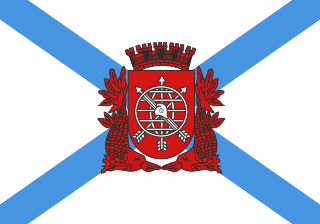
Rio de Janeiro, or simply Rio, is the second-most populous city in Brazil and the sixth-most populous in the Americas. Rio de Janeiro is the capital of the state of the same name, Brazil's third-most populous state, after São Paulo and Minas Gerais. Part of the city has been designated as a World Heritage Site, named "Rio de Janeiro: Carioca Landscapes between the Mountain and the Sea", on 1 July 2012 as a Cultural Landscape.

The Tijuca National Park is an urban national park in the mountains of the city of Rio de Janeiro, Brazil. The park is part of the Atlantic Forest Biosphere Preserve, and is administered by the Chico Mendes Institute for Biodiversity Conservation (ICMBio).
The Campeonato Carioca, officially known as Campeonato Estadual do Rio de Janeiro, was started in 1906 and is the annual football championship in the state of Rio de Janeiro, Brazil. It is under the authority of the FERJ or FFERJ.

Rio Comprido is a neighborhood located in the center (Centro) of Rio de Janeiro city, in Brazil. It borders the Catumbi, Estácio, Praça da Bandeira and Tijuca neighborhoods.

Laranjeiras is an upper-middle-class neighborhood located in the South Zone of Rio de Janeiro, Brazil. Primarily residential, It is one of the city's oldest neighborhoods, having been founded in the 17th century, with the construction of country houses in the valley located around the Carioca River, which bordered Corcovado Mountain. Because of this, the neighborhood was previously called Vale do Carioca, or Carioca Valley.
Carlos Renato de Abreu, known as Renato or Renato Abreu, is a Brazilian association football centre midfielder.
Alfredo Moreira Júnior, usually known as Zezé Moreira, was a Brazilian footballer and football manager that coached Brazil at the 1954 FIFA World Cup. He was born in Miracema, Rio de Janeiro, Brazil. He is a brother of Aymoré Moreira, winner of the 1962 FIFA World Cup and Ayrton Moreira, both of them successful coaches in the Brazilian football. In 1976, as Cruzeiro's manager, he won the Copa Libertadores.

Ibson Barreto da Silva, simply known as Ibson, is a Brazilian footballer who plays as a central midfielder for Amazonas.

Leonardo "Léo" da Silva Moura is a former Brazilian professional footballer who played for several clubs including Fluminense, Flamengo and Grêmio. Mainly a right back, he also played as a midfielder.
Fernando Gomes de Jesus, or simply Fernando, is a Brazilian defensive midfielder. He currently plays for Volta Redonda.

Itaboraí is a city in the state of Rio de Janeiro in Brazil, that belongs to the Rio de Janeiro metropolitan area. It was founded in 1672. In 2020, it had a population of 242,543.

Santa Teresa is the name of a neighborhood in the city of Rio de Janeiro, Brazil. It is located on top of the Santa Teresa hill, by the centre of Rio, and is famous for its winding, narrow streets which are a favourite spot for artists and tourists.
Júlio César Coelho de Moraes Júnior, best known as Júlio César, is a Brazilian former footballer who played as a defender.
Marlon Ventura Rodrigues, or simply Marlon, is a Brazilian central defender. He currently plays for Treze.
Paulo Sérgio Luiz de Souza or simply Paulo Sérgio, is a Brazilian striker who plays for Operário Ferroviário.

The Flamengo Basketball team is a professional Brazilian basketball team based in Rio de Janeiro. It is a part of the Clube de Regatas do Flamengo multi-sports club family. The club's full name is Basquetebol do Clube de Regatas do Flamengo. The club's commonly used short names are C.R.F. Basquete, C.R. Flamengo Basquete, Flamengo Basquete, and FlaBasquete.

The Suruí River is a river of Rio de Janeiro state in southeastern Brazil.
The South Zone is an area of the city of Rio de Janeiro situated between the Tijuca Massif, the Atlantic Ocean and Guanabara Bay. Most of it is made up of neighbourhoods along the Atlantic coastline, such as São Conrado, Vidigal, Leblon, Ipanema, Copacabana, and Leme.

The Guanabara Ecological Station is an ecological station in the state of Rio de Janeiro, Brazil. It protects an area of mangroves in Guanabara Bay, not far from the city of Rio de Janeiro.

The following outline is provided as an overview of and topical guide to Rio de Janeiro:










